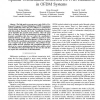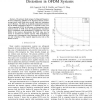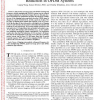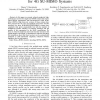5 search results - page 1 / 1 » Optimal constellation distortion for PAR reduction in OFDM s... |
PIMRC
2008
IEEE
13 years 11 months ago
2008
IEEE
Abstract—The high peak-to-average-power ratio (PAR) of Orthogonal Frequency Division Multiplexing (OFDM) transmission systems significantly reduces the power efficiency or perf...
ICC
2007
IEEE
13 years 11 months ago
2007
IEEE
Abstract— The primary disadvantage of orthogonal frequencydivision multiplexing (OFDM) is the high time-domain peak-toaverage power ratio (PAR) that severely limits the transmitt...
TSP
2008
13 years 4 months ago
2008
The peak-to-average power ratio (PAR) of orthogonal frequency division multiplexing (OFDM) systems can be reduced by using an optimal set of subcarrier signs. However, this sign se...
SIPS
2007
IEEE
13 years 11 months ago
2007
IEEE
Digital predistortion is a technique used to reduce the signal dynamic range in a multichannel system in order to improve power amplifier (PA) efficiency. These techniques have be...
VTC
2008
IEEE
13 years 11 months ago
2008
IEEE
Abstract—In this paper we present reduced-complexity highperformance receivers for single-user MIMO systems that employ coded OFDM transmission with bit-interleaved coded modulat...




